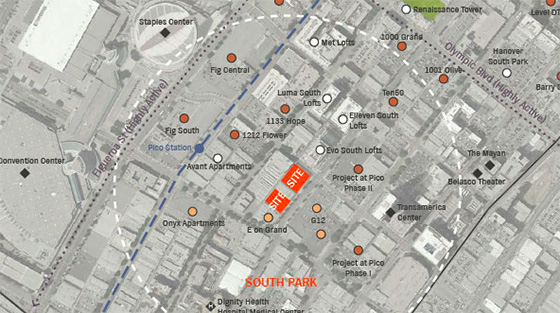Downtown Los Angeles is coming off a banner year.
In 2015, third quarter land sales reached $2.5 billion, significantly more than any other quarter recorded in DTLA as far back as 1990, according to data compiled by JLL.
However, a lack of continued heightened activity in 2016 suggests that DTLA could be headed into a downturn.
“Land sales have really slowed down,” said Rob McRitchie, a senior vice president at JLL. “Downtown LA is certainly on the map as a maturing market that ebbs and flows. But large developments? Right now, they are going through an ebb.”
In the first quarter of 2016, $44 million in DTLA land changed hands at an average of $339 a square foot. It was far less than the $173.8 million of land that traded in the first quarter of 2015.
The fluctuations make sense in an area where old industrial buildings and empty lots are giving way to multifamily developments fetching higher asking rents. However, McRitchie expects the rate and activity spikes of the last several years to continue to mellow until this new housing supply is absorbed in 2017 and 2018.
As for available land, there isn’t much of it. Even in what was once the wild west, for a city center anyway.
“The deals of the future will center on analyzing in-place assets and the land’s residual value, and working on getting the highest and best use designed for that piece,” McRitchie said.
The blue sky days in 2014 and 2015 reached peak with the $130 million sale of 14.6 acres of land in Downtown’s Arts District.
The buyer, SunCal, is expected to replace the site’s cold storage facilities with a large-scale mixed-use office and residential development. It’s a feat that will be challenging to replicate as DTLA land sales slim in 2016.
As the second quarter closes, land trades are still reaching a desirable average of $328.51 a square foot. However, it’s far less than February 2015, when the unentitled lots at 1201 and 1229 South Grand Avenue near Staples Center reached a record-setting $578 a square foot in a $26 million deal with Shanghai-based developer, Shenglong Group. The developer plans to raze the site’s 1930s warehouse to make way for two condominium towers.
Shenglong was part of a rush of investors seeking to capture rental dollars from a new wave of residents enamored with an evolving Downtown. But whether all the planned projects will come to life remains to be seen.
“There are tens of thousands of residential units that will be delivered in 2017 and 2018,” McRitchie said. “It’s a ‘wait and see’ as material and labor costs are increasing. There are a lot of variables that are giving pause to developers, and because of that, we are starting to see a plateau in pricing.”
